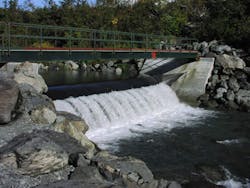Hydroelectric utility sees direct ROI on OPC data historian
The Power Creek Hydroelectric Project, located in Cordova, Alaska, began revenue service in January of 2001. The project is remotely operated, and automated to run unsupervised. The project directly offsets the use of diesel fuel to generate electricity for the community of Cordova.
On February 26th, 2004, at 10:09:18AM, CEC began collecting approximately 500 OPC data tags from the automation system. A quick glance at the Canary application provides the exact startup time of the Canary historian. CEC can mine the seven years of continuous data for much more useful information such as interior and exterior plant temperatures, turbine bearing temperatures, generator winding temperatures, power output and system frequency data, the status of electrical distribution system feeders and plant station service voltages, dam intake structure water elevations, and penstock pressures.
CEC estimates that the cost of automating two hydroelectric plants at a cost of $750,000 was recovered within three years. Canary Labs trending software was a key component of the savings derived, and continue to derive, from the automated system. Examples of cost savings include access to raw data for engineering studies and evaluations, preventative maintenance, and emergency maintenance. Two examples are listed below:
In August of 2009, during a peak system load on a relatively warm day for Cordova, the automation system indicated a high main bearing temperature on one of the hydroelectric turbines. The cost of removing the turbine from service at the time was $675 per hour in fuel cost, plus troubleshooting time and overtime for maintenance operators. A standard approach would have been to take the unit offline, remove cover plates, inspect the bearing, measure tolerances, change lube oil and filters, restart, test, and monitor the unit for temperatures. By looking at the seven years of historical bearing temperatures using the Canary trending, it was easy to see that there was no incremental increase to indicate a progressive failure. By utilizing the capabilities of the Canary Trend Link analysis tool, it was determined that the bearing lube oil sump cooling fan could be failing. The problem was quickly isolated to carbon and corrosion on the contacts. The entire evaluation, isolation, and correction of the alarm took less than an hour, and the hydroelectric turbine did not have to be taken out of service and replaced with diesel generation. The estimated savings of this one event was $20,000 in diesel fuel and labor.
In October of 2010, CEC sought a method to determine the amount of excess hydro that was running over the crest of the inflatable, rubber dam and on down the stream. This excess water represents the opportunity to increase sales, provide a low cost incentive rate, and spread fixed costs to lower the price of all electricity in the community. Four full years’ data from the Canary Historian was employed, and the calculations and associated graphs and data were compiled in one man day. The approximate cost of the study was $1,000. The estimated cost of a contract hydraulic engineer to perform a theoretical analysis based on historic stream flows and CEC power use curves is $20,000. The data set would likely be less accurate than the trended values.
There are many day to day applications of the trending software including analysis of power use patterns in the community, loads on portions of the system before, during, and after outages, and system studies of power factor, voltage drop, load balance, and economic dispatch of units.
Clay Koplin, CEO of Cordova Electric, states “The Canary software is a low-cost, high value, user-friendly solution for our system wide data storage and analysis.
For more information, visit www.canarylabs.com.

